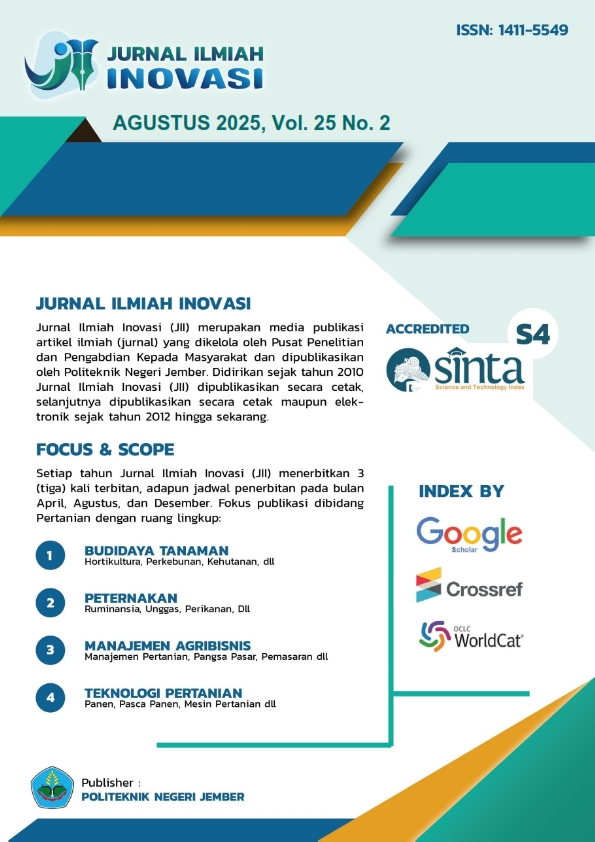Pengolahan Pasca Panen Kopi Arabika dengan Metode Kering (Honey Process) di PT. Sinar Mayang Lestari
DOI:
https://doi.org/10.25047/jii.v25i2.6169Keywords:
kopi arabika, fermentasi kering, honey processAbstract
Kopi arabika merupakan jenis kopi yang ditanam di dataran tinggi dan memiliki rasa yang unik (sedikit asam) dibandingkan dengan kopi robusta. Salah satu perusahaan nasional yang melakukan agribisnis kopi berkelanjutan adalah PT. Sinar Mayang Lestari. Produksinya dimulai dari perkebunan (pembudidayaan kopi arabika), pengolahan pasca panen, pengolahan green bean kopi (roasting) hingga pemasaran dengan membuka outlet sendiri (Malabar Mountain Caffe). Tujuan penelitian ini adalah untuk mengetahui pengolahan pasca panen kopi arabika dengan metode kering (honey process). Metode penelitian yang digunakan adalah analisis deskriptif dengan melalui kegiatan wawancara pakar dan observasi partisipasi. Hasil penelitian menunjukkan bahwa PT. Sinar Mayang Lestari melakukan pengolahan pasca panen kopi arabika dengan honey process yang terdiri dari pemetikan cerry kopi arabika, perambangan (pencucian), pengupasan kulit kopi (pulping), fermentasi spontan dengan sisa mucilage 25% (yellow honey), 50% (red honey) dan 75% (black honey), penjemuran di atas para-para, pengupasan kulit tanduk (hulling), sortasi green bean dan pengemasan. Metode kering khususnya honey process akan menghasilkan rasa kopi yang lebih sweet karena dihasilkan dari fermentasi lendir cerry kopi oleh mikrobia secara spontan.
Downloads
References
[1] R. A. Bintang, “Indonesia Jadi Produsen Kopi Terbesar ke-4 di Dunia,” data Goodstat.
[2] Anonymous, “Ekspor Kopi Menurut Negara Tujuan Utama Tahun 2000-2020.,” Jakarta: Badan Pusat Statistik, 2021.
[3] L. Kasyfillah and I. Setiawati, “Pasca Panen dan Pemasaran Kopi Arabika di PT. Sinar Mayang Lestari, Kecamatan Pangalengan, Kabupaten Bandung,” Agricore: Jurnal Agribisnis dan Sosial Ekonomi Pertanian, vol. 7, no. 2, pp. 108–122, 2022, doi: https://doi.org/10.24198/agricore.v7i2.40433.
[4] F. Lia and T. Perdana, “Sistem Produksi Kopi Arabika (Studi Kasus PT. Sinar Mayang Lestari< Kecamatan Pangalengan, Kabupaten Bandung),” AGRISEP, vol. 16, no. 2, pp. 123–132, 2017.
[5] Y. D. Kartika, A. Rifin, and I. T. Saptono, “Strategi Pengembangan Usaha Pengolahan Kopi Arabika (Studi Kasus PT Golden Malabar),” Jurnal Aplikasi Bisnis dan Manajemen, May 2018, doi: 10.17358/jabm.4.2.212.
[6] M. Haile and W. H. Kang, “The Role of Microbes in Coffee Fermentation and Their Impact on Coffee Quality,” J Food Qual, vol. 2019, 2019, doi: 10.1155/2019/4836709.
[7] P. Vaast, B. Bertrand, J.-J. Perriot, B. Guyot, and M. Génard, “Fruit thinning and shade improve bean characteristics and beverage quality of coffee (Coffea arabica L.) under optimal conditions,” J Sci Food Agric, vol. 86, no. 2, pp. 197–204, Jan. 2006, doi: https://doi.org/10.1002/jsfa.2338.
[8] C. F. Silva, L. R. Batista, L. M. Abreu, E. S. Dias, and R. F. Schwan, “Succession of bacterial and fungal communities during natural coffee (Coffea arabica) fermentation,” Food Microbiol, vol. 25, no. 8, pp. 951–957, 2008, doi: https://doi.org/10.1016/j.fm.2008.07.003.
[9] G. V. de Melo Pereira et al., “Isolation, selection and evaluation of yeasts for use in fermentation of coffee beans by the wet process,” Int J Food Microbiol, vol. 188, pp. 60–66, 2014, doi: https://doi.org/10.1016/j.ijfoodmicro.2014.07.008.
[10] C. F. Silva, D. M. Vilela, C. de Souza Cordeiro, W. F. Duarte, D. R. Dias, and R. F. Schwan, “Evaluation of a potential starter culture for enhance quality of coffee fermentation,” World J Microbiol Biotechnol, vol. 29, no. 2, pp. 235–247, 2013, doi: 10.1007/s11274-012-1175-2.
[11] O. L. Farm, “Protocols and Best Practices,” California, 2018. Accessed: Jun. 27, 2025. [Online]. Available: A Specialty Coffee Association
[12] R. F. Schwan and G. H. Fleet, Cocoa and Coffee Fermentations, 1st ed. Boca Raton: CRC Press, 2014. doi: 10.1201/b17536.
[13] K. Velmourougane and R. Bhat, “Sustainability Challenges in the Coffee Plantation Sector,” in Sustainability Challenges in the Agrofood Sector, 2017, pp. 616–642. doi: https://doi.org/10.1002/9781119072737.ch26.
[14] C. Erika and F. Muzakki, “Physical properties of arabica green coffee beans grown at different farm elevations in Gayo higland, Indonesia,” in IOP Conference Series: Earth and Environmental Science, IOP Publishing, 2025, p. 012096.
[15] Badan Standardisasi Nasional, SNI 01-2907-2008: Biji kopi . Jakarta: https://www.cctcid.com/wp-content/uploads/2018/08/SNI_2907-2008_Biji_Kopi-1.pdf, 2008.
[16] K. Velmourougane, T. N. Gopinandhan, and R. Bhat, “Application of Hazard Analysis and Critical Control Point Principles for Ochratoxin‐A prevention in Coffee Production Chain,” Practical Food Safety: Contemporary Issues and Future Directions, pp. 577–595, 2014.
[17] M. Pranadikusumah, V. Rostwentivaivi, and A. Quddus, “Development of Good Manufacturing Practice (GMP) in the Form of a Practical-Oriented Application for Household Coffee Processing Guidelines,” in Proceedings of the 1st International Conference on Islam, Science and Technology, ICONISTECH, 2019, pp. 11–12.
[18] K. T. Raharja, “Laporan Kegiatan Retooling Kompetensi Dosen Vokasi Tahun 2019,” 2019.
Downloads
Published
How to Cite
Issue
Section
License
Copyright (c) 2025 Anna Mardiana Handayani, Kristian Triatmaja Raharja, I Wayan Sudarma

This work is licensed under a Creative Commons Attribution 4.0 International License.
Copyright Notice
Authors who publish with this journal agree to the following terms:
- Authors retain copyright and grant the journal right of first publication with the work simultaneously licensed under a Creative Commons Attribution License that allows others to share the work with an acknowledgement of the work's authorship and initial publication in this journal.
- Authors are able to enter into separate, additional contractual arrangements for the non-exclusive distribution of the journal's published version of the work (e.g., post it to an institutional repository or publish it in a book), with an acknowledgement of its initial publication in this journal.
- Authors are permitted and encouraged to post their work online (e.g., in institutional repositories or on their website) prior to and during the submission process, as it can lead to productive exchanges, as well as earlier and greater citation of published work (See The Effect of Open Access).






